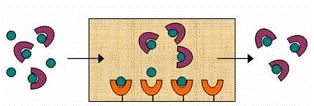Department of Chemistry
Document Type
Article
Date of this Version
5-2011
Citation
Published in final edited form as: Curr Drug Metab.2011 May ; 12(4): 313–328. Version presented here is from NIH PubMed Central.
Abstract
The binding of drugs with serum proteins can affect the activity, distribution, rate of excretion, and toxicity of pharmaceutical agents in the body. One tool that can be used to quickly analyze and characterize these interactions is high-performance affinity chromatography (HPAC). This review shows how HPAC can be used to study drug-protein binding and describes the various applications of this approach when examining drug interactions with serum proteins. Methods for determining binding constants, characterizing binding sites, examining drug-drug interactions, and studying drug-protein dissociation rates will be discussed. Applications that illustrate the use of HPAC with serum binding agents such as human serum albumin, α1-acid glycoprotein, and lipoproteins will be presented. Recent developments will also be examined, such as new methods for immobilizing serum proteins in HPAC columns, the utilization of HPAC as a tool in personalized medicine, and HPAC methods for the high-throughput screening and characterization of drug-protein binding.



Comments
Copyright Bentham Science. Used by permission.